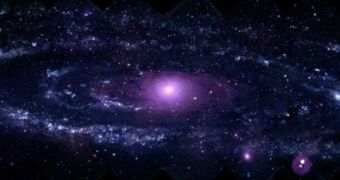For many years astrophysicists have been puzzled at precisely how supermassive black holes at the center of large galaxies gobble up so much of their surrounding gas. When the matter passes a certain threshold, as in when it approaches to less than 30 percent of a light-year from the event horizon, it gets sucked in due to the extremely strong gravitational pull of the holes, but no one knew for sure how the structure exerted its influence when it came to gas located much farther away. Now, experts propose a new mechanism for this, Wired reports.
The thing about gas located much farther away is that it spins very rapidly around the core regions of massive galaxies, where black holes reside. As such, they have a massive angular momentum, which in turn causes a centrifugal force that should be enough to keep them from falling through the event horizon. The magnetic fields around the dark behemoths are known to act as brakes for the swirling gas, reducing their speed enough to that the gravitational tug prevails. But this happens at close range. At larger distances, of between 30 to 300 light-years, things change drastically.
When located so far away from the black hole, the gas is not driven into the event horizon by the direct influence of the central structure. Rather, disturbances from galactic collisions, or the gravitational interaction of matter in the galaxy, make the gas move inwards, until it's gobbled up. But researchers say that, while these mechanisms are very well understood, these theories leave behind a large gap, where astrophysicists don't know how to address what happens in the range between 1 to 30 light-years away from the black hole. Here, the experts know of no force that is capable of reducing the rotational motions and centrifugal forces that drive gas.
In a purely theoretical model, experts show that stars at these intermediate distances form lopsided disks around them, which are offset in respect to the black holes. The interactions between these disks and gas drive the latter closer to the core of the galaxy. The new computer model could help explain such lopsided disks that were discovered near the core of large galaxies, such as our neighboring Andromeda. For more than a decade, astronomers have been scratching their heads at to what these structures might mean, and what their function could be.
The new paper “is interesting in that it may explain such oddball [stellar disks] by a common mechanism which has larger implications, such as fueling supermassive black holes. The fun part of their work [is combining] the very large-scale black hole energetics and fueling with the small scale,” says of the recently-developed model National Optical Astronomy Observatory in Tucson expert Tod Lauer.

 14 DAY TRIAL //
14 DAY TRIAL //